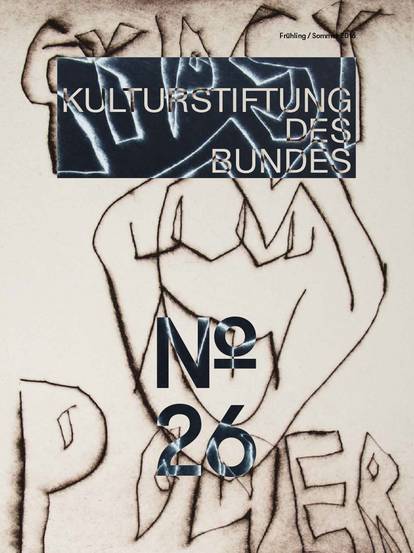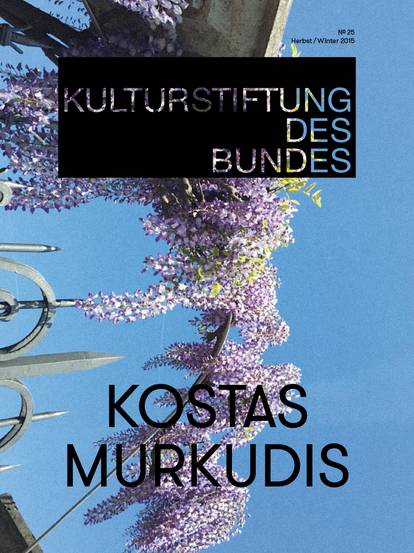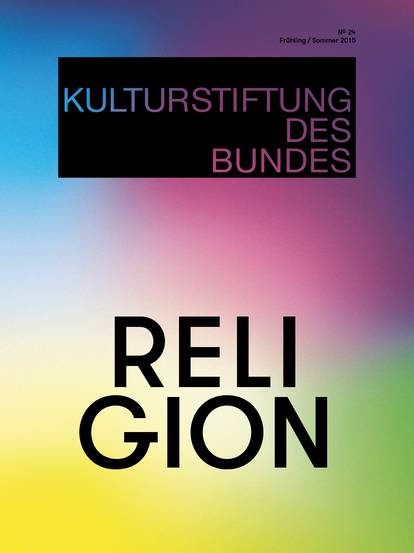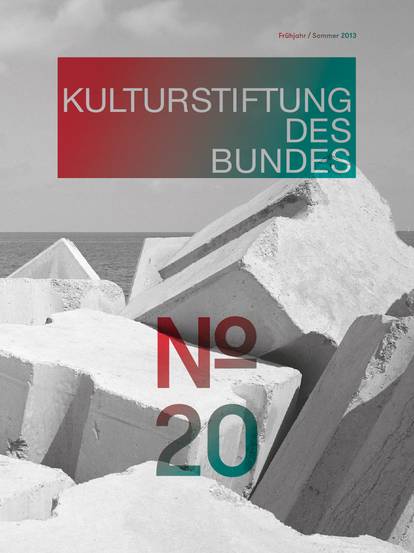Cohabitation in Cultures of Remembrance I – Historian Mirjam Zadoff laments that there is an inadequate regard for diversity when it comes to addressing the past and its consequences for the present.
Nothing remains of the largest propaganda exhibition of the Third Reich. And what should have? Plaster, paper, plywood – that is all that’s left from what was touted as “Europe’s largest exhibition” which opened in November 1937. Entitled “The Eternal Jew”, the Deutsches Museum in Munich presented a massive display of inflammatory anti-Semitism spanning 3,500 square metres in 20 rooms and featuring items, falsified statistics, horrendously enlarged photos and ominous-looking world maps. An enthusiastic Goebbels made an appearance, school classes were forced to attend, over 5,000 visitors came each day. The exhibition went on tour to Vienna, Berlin, Bremen, Dresden and Magdeburg, and was viewed by more than a million people. In autumn 1941, a similar exhibition was shown to French audiences in German-occupied Paris.
Praising the work of the curators and researchers, the "Völkischer Beobachter" concluded “the purpose of this absolutely objective, almost dispassionate exhibition is to open our eyes by means of irrefutable documents.” These objective documents included noses, enormously magnified noses, mouths and ears, grotesque carnival specimens in museum display cases. Interspersed among these were small, almost unremarkable plaster masks of German Jews – living masks made in concentration camps, through which deported and tortured people were transformed into exhibition objects.
The tradition of producing living masks dates to the late 19th century when plaster masks were made of the indigenous people of the German colony Papua-New Guinea, which were later hand-painted and presented in the Berlin Wax Figure Cabinet. This colonial technique of transforming faces into research objects was soon replaced by photography. It is no coincidence that the Nazi curators resorted to this colonial practice in 1937. The idea was to present Germans as strangers, to make familiar faces appear “uncivilised”, to turn neighbours into enemies. The intent of the material and technique was to visualise what was repeated every day in propagandistic slogans and inflammatory speeches: that there were Germans who were entitled to everything, and others who were deprived of everything – including being German and the rights attached to that distinction [Mirjam Zadoff, Der rote Hiob. Das Leben des Werner Scholem, Munich 2014.].
The Weimar Republic was undoubtedly a problematic, flawed and fragile democracy, yet its society was more open and diverse than any Germany had experienced before. Weimar provided freedoms and a new self-understanding to women, minorities and a largely muted younger generation. In 1933, this rapidly expanding social diversity was expunged from public life with every means, museums and libraries were cleansed of it, and its representatives were oppressed and persecuted. This diversity was replaced by an imagined “Volksgemeinschaft” (community of the people) – white, homogenous, nationalistic, anti-Semitic – a society which supposedly represented the continuity of German culture and tradition, while trying to erase the history of modern migration.
Most Jews who were designated as foreigners and enemies after 1933 had been living in Germany for generations. To justify isolating, disenfranchising and persecuting them, the Nazis used hostile, anti-Semitic images and mixed them with (anti-)modern conspiracy theories and pseudo-scientific racial research findings. To segregate a society of intertwined friendships, marriages and business partnerships along race-ideological lines, the Nazis drew inspiration from German colonial history. During the era of imperial expansion, for instance, there were a number of research projects conducted in Namibia on “racial separation” and “racial mixing”. They were also inspired by another Western country which had long practiced racial segregation – the United States. For example, numerous “anti-miscegenation laws” prohibited marriage between Whites and Blacks across most of the US until 1948 (and well into the 1960s in the southern states). According to the “one-drop rule” of the Jim Crow era, just one drop of “Black blood” was enough to make someone “not white”, thereby denying them all the rights and privileges of White people [Source: New Yorker (external link, opens in a new window)].
Research in recent years has provided further evidence of how National Socialism had been inspired by such forms of segregation. At the same time, the Nazi regime never concealed that other elements, starting with the first concentration camps and the cruelty practiced within this system, were inventions of their own making. Without relativising German guilt or calling the radically evil nature of the Nazis into question, these influences remind us that National Socialism didn’t simply form in a vacuum. Rather, it was rooted in practices of segregation, exclusion and persecution – from anti-Jewish pogroms to colonial settlement policies as a model for “Germanising” eastern Europe – all references that the perpetrators themselves brought into play. Allow me to offer an example of why contextualising and visualising such continuities – and ruptures – is central for discussions about remembrance.
In 2020 the Munich Documentation Centre for the History of National Socialism staged an exhibition (with funding provided by the Federal Cultural Foundation) entitled Tell me about yesterday tomorrow (opens in a new window). Over 50 works of art, some of which were exclusively produced for the exhibition, addressed questions concerning the German culture of remembrance or engaged in dialogue with other cultural and national discourses on traumatic past events. Also in the rooms of the historical permanent exhibition “Munich and National Socialism”, a number of works were thoughtfully displayed in cooperation with guest curator Nicolaus Schafhausen. One of the pieces, titled “Entryways” by the American artist Diamond Stingily, featured a banged-up wooden door against which a baseball bat was leaning. Stingily highlighted the violence and exposure that shape the everyday lives of African Americans and people of colour in the United States. To the artist, this image also had a positive connotation in that it called to mind the protected place her grandmother had made for her grandchildren. In Munich, “Entryways” was surrounded by photos and documents documenting the disintegration of solidarity and the increasing radicalisation of Munich’s society in the early 1920s by the nascent Nazi movement and its sympathisers in politics, police departments and the courts.
When a group of American politicians visited the exhibition in winter 2020, this work and its placement elicited an emotional discussion about how Germans view their own history and what challenges this presents in the American context. The Trump presidency had provoked fierce socio-political debates, from which one could see how centrally important national history was for the current crisis of democracy. During their discussion, one of the politicians remarked that the Nazis were absolutely evil and therefore could not be compared with anything else. Characterising perpetrators as inhuman monsters is not only wrong, it’s lazy and therefore dangerous. It is their humanity that makes the perpetrators truly heinous and awful, also in the occasionally overlooked grey zones of history – in the insidious radicalisation of a tolerant society, in the loss of empathy toward friends, neighbours or colleagues who are suddenly maligned as enemies; in the responsibility of enablers and supporters, as was the case with Hitler and Munich’s upper class and industry, and of course, in the role of the inconspicuous followers, profiteers and the silent many who comprised the backbone of the regime. These grey zones also speak of the relevance and necessity of social solidarity, responsibility and civic courage.
What many today proudly refer to as achievements of the “German culture of remembrance” is something we owe first and foremost to the survivors. In 1966 Jean Améry worried that one day German adolescents would again be able to quote Goethe without mentioning Himmler. Améry was one of many survivors who painfully witnessed German suppression and ignorance in the post-war years. They were the ones who fought the decades-long, uphill battle of remembering, and it took them until the 1980s and 1990s for their stories to finally reach a broad audience.
At the end of the 1980s, Saul Friedländer engaged in what became an extraordinary exchange of letters with Martin Broszat, the director of the Munich Institute of Contemporary History. Broszat held the view of German contemporary history which at the time tended to discount the memories of survivors as “historically oversimplified legend” in favour of the scientifically substantiated material estates of the perpetrators. In effect, the perpetrators and their offspring were believed to be more objective and neutral than contemporary witnesses and their descendants. Friedländer, a survivor himself and professor of history in Israel and the USA, begged to differ. He proposed an “integrated history” that combined the perspectives of both the perpetrators and victims, and so doing, would enable it to free itself from the prerogative interpretation of the perpetrator nation. [Martin Broszat/Saul Friedländer, Um die Historisierung des Nationalsozialismus, In: Vierteljahrshefte für Zeitgeschichte 36 (1988) 2, 339-372.] Friedländer’s call for a multi-perspective approach to remembrance sparked a long-overdue shift in how Germans reflected on Nazi crimes – and it can serve as the model for addressing other traumas, e.g. racial and colonial oppression. Its history shows how important resistant thinking has been in the formation of discourse on remembrance – and still is today.
Have we then done everything right? Can we be proud of a culture of remembrance that has established itself in German downtowns and parliaments, and which could even become a top export? This is rather unlikely in view of recent calls in these same parliaments for a “commemorative shift”, and that through these same downtown districts, pandemic deniers are marching alongside conspiracy theorist and right-wing extremists, declaring themselves victims of a “coronavirus dictatorship”, donning yellow stars on their chests and invoking comparisons with Anne Frank and Sophie Scholl. What has gone wrong when violent anti-Semitic and racist attacks are on the rise, when right-wing extremist ideology spreads among the police and military – without society resisting with one voice in solidarity with the victims? Or when during the same week of the International Commemoration for the Victims of National Socialism – including the persecuted and murdered Roma and Sinti who in the past have been disparaging called “gypsies” (German: "Zigeuner") – members of a TV talk show ranted that there was really nothing offensive about the term “Zigeunerschnitzel” (gypsy schnitzel). Have our history classes failed us? Or is it just a natural process that memory will fade as time passes? As important as ritualised commemoration is, if it does not engender a responsibility for political action, for humaneness and empathy, it will remain meaningless and is susceptible to becoming instrumentalised.
Recently I was asked in an interview whether places of Jewish culture in Germany today should be regarded as commemorative sites. This question reveals the core of a larger problem in our culture of remembrance. Synagogues, cultural centres of the Roma and Sinti, or queer archives are not commemorative sites of German crimes and genocide. They are symbols of what has been forgotten: the history of diversity that existed prior to 1933, which the Nazis “cleansed” from libraries, museums, archives and public awareness, and the continuity of this diversity after 1945. The risk of being erased from European memory was all too obvious to the persecuted. In the Warsaw Ghetto, a group of activists formed around the historian Emanuel Ringelblum and collected every document and artefact they could get their hands on – not only to document the history of the Ghetto and the persecution of its inhabitants, but also the history of the Polish Jewish community before 1939. To this day, the books Wolfgang Herrmann placed on his “blacklist” of 1933 can no longer be found in German libraries, and even today, Jews play no role in school curricula and if they do, then only as persecuted victims – but not where their place should be, namely at the centre of German history as a multi-perspective narrative. Diversity, present and past, has not been adequately inscribed into German cultural awareness; the aim should be to discover new stories and celebrate forgotten people.
To defend ourselves against global right extremist alliances, we need an open society in which minorities are protected unconditionally and can participate in democratic processes and discourses on remembrance – not as an audience that requires cultivation, nor as “objects” in the collection areas of museums, archives or libraries, but rather as active participants of a diverse culture and memory.

![[Translate to English:] Magazine 38](/fileadmin/_processed_/f/1/csm_Magazin38_Cover-Vorschau_921x1230_689f428dc3.jpg)
![[Translate to English:] Magazine 37](/fileadmin/_processed_/b/c/csm_Mag37_Cover-Vorschau_921x1230_b5129fdb2a.jpg)
![[Translate to English:] Magazine 36](/fileadmin/_processed_/2/a/csm_Cover_Magazin36__issuu_2f3cef97bb.jpg)





![[Translate to English:] Magazine 30](/fileadmin/_processed_/c/b/csm_magazin30_vorschau_9005f773d3.jpg)














